Robert Lee “Chief” Myers and His Goal of Centre Playing a Member of College Football’s “Big 3”
You may find this chapter a little lengthy. You will be correct.
You may also look at the index and find that there are 135 chapters and think, "I'm not certain that I have enough life left to read this book!"
Let me explain.
In order to understand the almost unbelievable accomplishments that Centre achieved now over a century ago, you have to start at the beginning of the creation of the team which captivated the attention of America after the "Great War," World War I.
You have to learn about the young man who had the dream, Robert L. "Chief" Myers.
You have to learn about the Fort Worth, Texas connection.
You have to learn about the Somerset, Kentucky connection.
You have to learn about the coach who made it all happen on the field, Charles. B. "Uncle Charlie" Moran.
You have to learn about the state of college football during the era and how Centre planned to change that perception.
This chapter addresses all of these issues and others and will take you through the war-shortened 1918 season. Then the following chapter will begin the 1919 meteoric rise of Centre beginning to achieve national recognition and become known as the "Wonder Team."
So, stick with me and let me tell you about what I consider the most improbable, fascinating story ever in the long, glorious history of college football.
_________________________________________________________________________
On October 29, 1921, little Centre College from Danville, Kentucky beat Harvard University, the most prestigious university in the United States, in a football game played in the classically beautiful edifice, Harvard Stadium, along the Charles River.
It was a game which captured the attention of much of the nation because of its improbability and the public's fascination with the young men who pulled off what has been considered as "the greatest upset in the history of college football" for over a century.
It was made possible by events which took place some decade earlier in the most unlikely of locations, North Side High School of Fort Worth, Texas.
Centre and the Fort Worth, Texas Connection
From his earliest days at Centre College, Robert Lee Myers, Centre ’07, had possessed an almost mystical vision of creating a national, football power at the little school.
( Officially, in 1907, Centre College was "The Centre College and Central University in Danville." That situation is discussed in detail in Chapter 126. We won't consider that now. )
It was a dream that almost bordered on the ridiculous.
Here was a man of modest physical talents who wanted to be part of the Centre football team and was allowed to suit up in 1905 but never played enough to earn a letter. Myers was more at home in the classroom than on the gridiron.
He was born in Atchison, Kansas, but his family moved around the country before eventually settling in Chicago. He attended high school in Fort Worth and Philadelphia, entering Centre as a 16 year-old freshman in the fall of 1903.
Myers was a brilliant young man. He was editor-in-chief of the college newspaper, The Cento, wrote for the Ec Centric, which was the name of Centre’s yearbook in 1907, was secretary of the Deinologian Literary Society, and was voted “brightest man of the campus” upon graduating.

Robert L. Myers- Centre '07
After leaving Danville, he returned to Chicago and joined his father’s business booking talent for chautauquas, which were traveling, summer shows popular in the late nineteenth and early part of the twentieth centuries, bringing “culture” to areas in the country lacking such attractions.
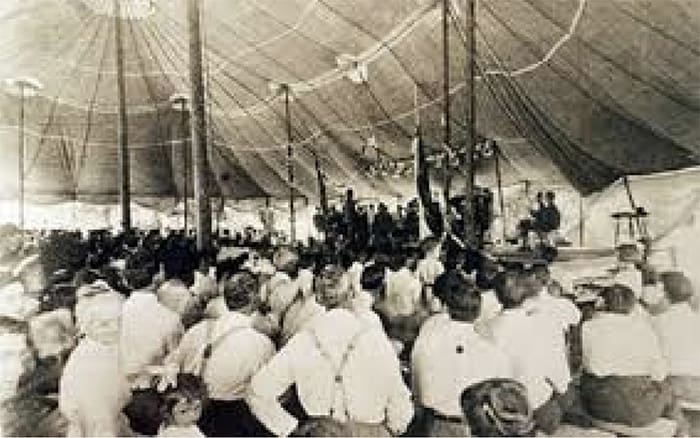
Attending a chautauqua, a common summer event over a century ago

Listing in "The Complete Chautauquan" about the booking agency, Midland Chautauqua Circuits, run by Myers and Trimble, with Robert L. Myers' father as an owner
Bob wanted to be more than just an employee in his father’s chautauqua booking agency. He couldn’t get over his desire to build Centre College into a football powerhouse.
Myers became a student of football tactics by attending clinics held by the famous coach at the University of Chicago, Amos Alonzo Stagg, and studied manuals produced by Glenn “Pop” Warner of the Carlisle “Indians,” which included the famous Jim Thorp. His desire to master football tactics actually led him to meet with Warner at the Carlisle Army Barracks in Pennsylvania to watch him conduct practices.
By 1912, Myers, now having just turned 25, made his move.
He attained a position as an English and science teacher at North Side High School in Fort Worth, and was also made the football coach, a position he had sought.
During the summer of his arrival in Fort Worth prior to the beginning of the school year, Myers met a young man at a Fort Worth Panthers minor league baseball game who apparently had tried to sneak into the game. Myers intervened with a security officer and offered to pay for the boy's ticket.
The boy was Alvin Nugent "Bo" McMillin.

"Bo" was his nickname from the time he first began to walk
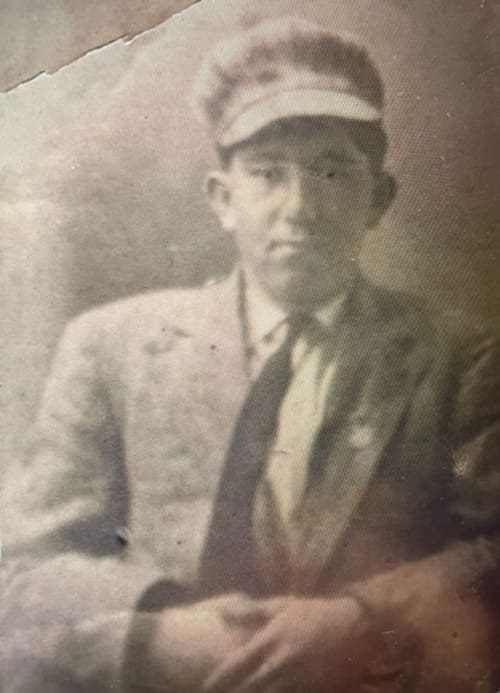
Alvin Nugent "Bo" McMillin
Myers learned that Bo had dropped out of school after the 8th grade in order to work and help his family but he may try to get back into school again even though his father, Reuben, had died the year before.
Myers encouraged him and told him that he would not only help with his studies but since he was the new football coach, he'd also get him on the team.
That simple act of kindness began a relationship which brought both Myers and Bo McMillin fame beyond what they could have ever foreseen, in their wildest dreams, on that summer night in 1912 at Panther Park in Fort Worth, Texas.


Myers' first team, fall of 1912. Bo McMillin and Bob Mathias ( 1st row, 3rd left ) ended up at Centre. The second and third rows have the caption written which makes it seem that all of the boys are on the same row, so Bo McMillin is 4th from right on top row. Coach Myers is on the far right, top row.
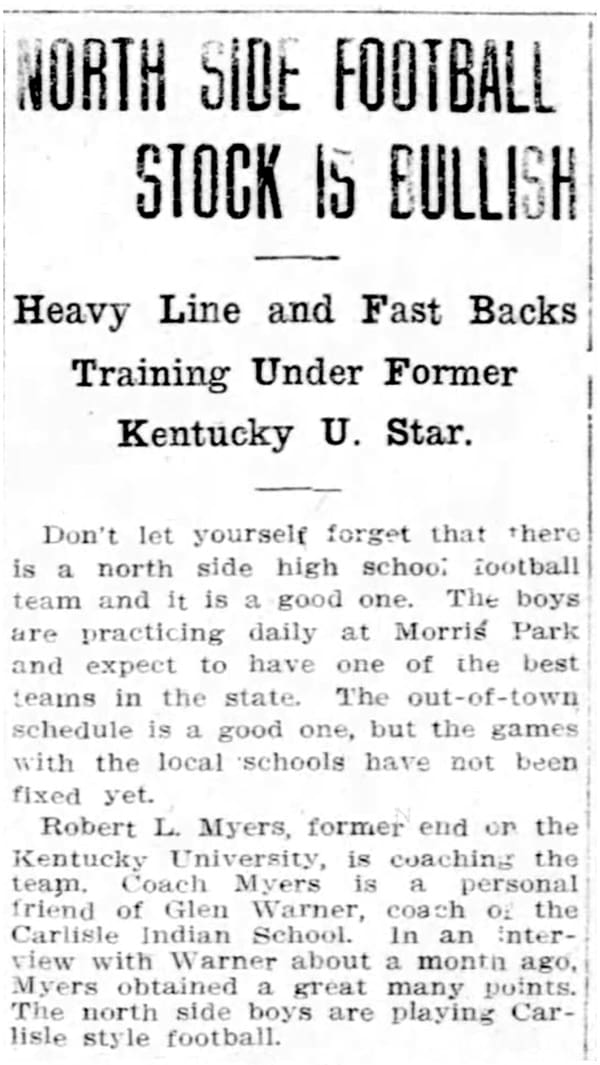
Article in the October 3, 1912 Fort Worth "Star-Telegram" which is the first acknowledgment regarding Myers being at North Side as the football coach. The headline indicating that he was a "Former Kentucky U. Star" somewhat overstates Myers' football prowess as he was a scrub and non-letter winner at Centre during his one season sitting on the bench in 1905.
Myers was given the nickname "Chief" by his North Side players, derived from a player on the New York Giants from 1909-15.

Inspiration for the nickname
The "Chief" developed quite a successful football program, with his 1914 team winning the North Texas Championship by defeating Amarillo High 14-6 before falling to Austin High, 23-0, at Fort Worth's Panther Park in the overall State Championship game.
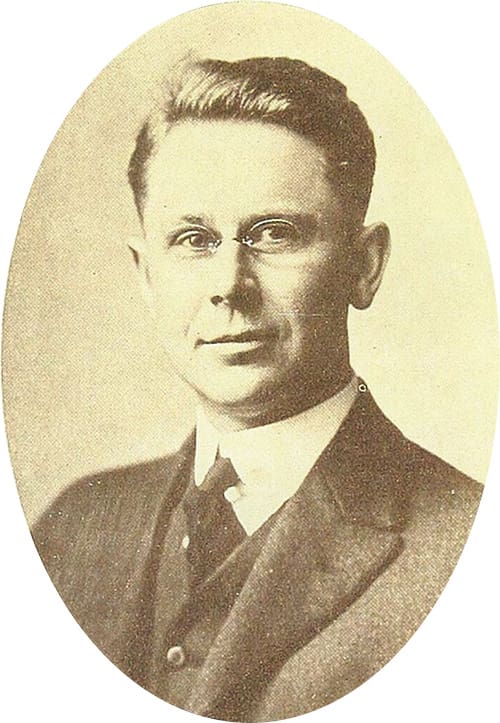
Coach Robert L. "Chief" Myers from "The Lasso," the North Side High yearbook

1914 North Side football team with individuals captioned who eventually went to Centre. The only future Centre players not included are Reuben McMillin, discussed later, whose last year at North Side was several years previously, and James "Sully" Montgomery, who graduated in 1918 and entered Centre in the fall of that year.
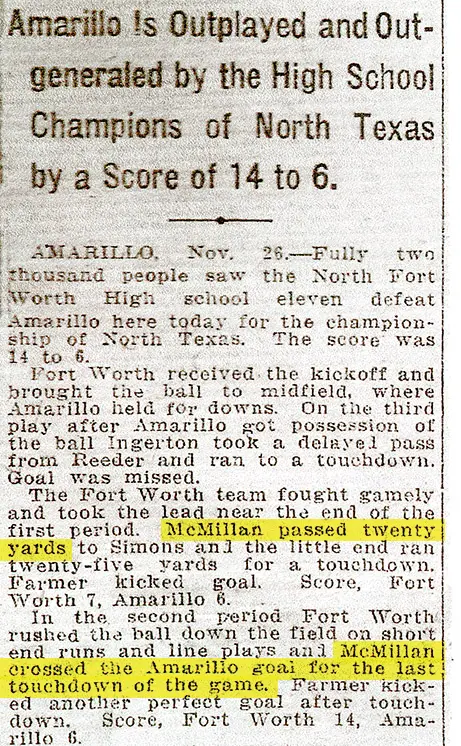
In 1914, the state's championship for North Texas was won by Fort Worth North Side High over Amarillo High. The Texas high schools annually crowned a North Texas and South Texas Champion which later played for the overall Texas state title. Bo McMillin passed for the first score and ran for the second in the win. Bo's name was misspelled as "McMillan."

Austin High, above, beat North Side, below, for the overall 1914 Texas State Championship, 23-0, at Fort Worth's Panther Park. The starters on the North Side team ( lower photo ) include Red Weaver, first row, 4th from left. Second row, Bob Mathias, 1st left, and Bo McMillin, 4th left.
North Side won a second straight North Texas title in 1915 and was undefeated after crushing Fort Worth Central, 47-0, before once again losing to Austin High, 6-0, in the State Championship game at the University of Texas Stadium in Austin.

1915 North Side team with Coach Myers in suit with whistle. In an unbalanced line formation, six future Centre players included Bo McMillin partially visible, far right, back row. The front row has Matty Bell, far left, with Bill James next to him. Bill Boswell is 4th from left with head down and next to him is Red Weaver, centering the ball. Sully Montgomery is right of Weaver.
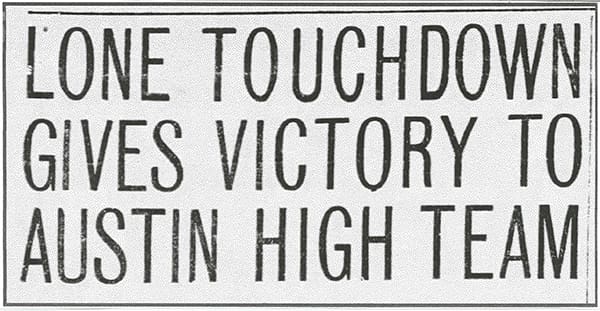
Headline in Fort Worth "Star-Telegram" after 1915 State Championship game with Austin High, again the winner

Fort Worth North Side team, fall 1915 -champions of North Texas after beating Fort Worth Central, 47-0 before falling again to Austin High in the State Championship game
Individuals who ended up at Centre include-
First row- Bill James, 2nd left
Second row- Chief Myers, 1st left, standing Bill Boswell, 2nd left Madison ( Matty ) Bell, 5th left
Third Row- Bo McMillin, 1st left Red Weaver, 4th left Thad McDonnell, 5th left
Bob Mathias, who entered Centre with Matty Bell in the fall of 1916, had graduated in the spring of 1915 but didn't enter Centre until 1916 when Chief Myers took some of his players to Danville that fall. Sully Montgomery isn't in the photo.
Myers lived by a philosophy he had embraced earlier at Centre- Credendo Vides-"To Believe is to See."
He constantly reminded his young players that they could accomplish anything if they adopted the belief that they could achieve their dreams, and that their achievements would allow them to be successful in the realization of anything they could imagine.
BELIEVE!
ACHIEVE!
SUCCEED!
It was printed in the locker room at North Side.
( My father, Robert Wintersmith “Red” Robertson, Centre ‘25, told me years later and that he remembered seeing the words on the locker room wall at Centre when he was the student manager for the freshman team serving under Red Roberts in the fall of 1924 ).
Chief Myers' last year for coaching North Side was during the fall 1915 season, and after the school year, he returned to Chicago to work for his father's chautauqua booking business. A new coach named Keen took over the program in 1916 and three future Colonels, Bill James, Bill Boswell, and Sully Montgomery, were on North Side's 1916 team which lost to Fort Worth Central High in the Fort Worth City Championship game, 6-0.
Myers felt he had enough developed enough talent during his 4 years at North Side that he returned to Fort Worth later during the summer of 1916 to begin recruiting his former players to attend Centre. He had told stories about Centre to his young men since first arriving in Fort Worth and North Side High and now hoped that those "word pictures" which he had painted for his team about this "beautiful little college in Kentucky's Bluegrass region" would bear fruit. He also hoped to obtain a football coaching position at Centre. He was successful in beginning to get his players to Danville but failed in his attempt in securing the coaching job at his alma mater during the fall of 1916.
Myers had plans for 6 former North Side players to enroll at Centre in the fall of 1916. Of these, 1 had graduated in the spring of 1912 before Myers had arrived in Fort Worth. The other 5 were his former players, including 1 who had graduated in 1915, and 4 in the spring of 1916. He also had plans for 3 other of his young men to follow later, 2 in 1917 and 1 in 1918, for a total of 9.
Perhaps the best way to understand how the nucleus of the future Centre football team was built by Myers is by following the chart of these 9 young men below to see when they graduated from high school and when they actually enrolled in Centre.
PLAYER | GRADUATED FROM | ENTERED CENTRE |
|---|---|---|
Reuben McMillin | 1912 | 1916 |
Bob Mathias | 1915 | 1916 |
Matty Bell | 1916 | 1916 |
Red Weaver | 1916 | 1917 |
Bo McMillin | 1916 | 1917 |
Thad McDonnell | 1916 | 1917 |
Bill James | 1917 | 1917 |
Bill Boswell | 1917 | 1917 |
Sully Montgomery | 1918 | 1918 |
Reuben McMillin, Jr., the first on the list above, was Bo's older brother and one of the 6 sent to Centre in the fall of 1916 by Chief Myers. Reuben was born on February 11, 1892 and died May 31, 1955 at age 63. He graduated from North Side High School in 1912 after being the captain and star fullback on the 1911 team.
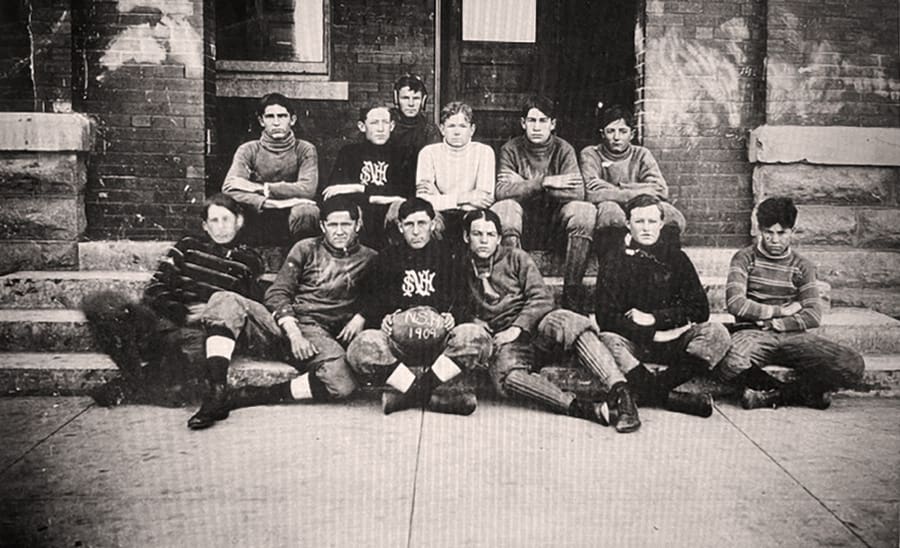
1909 Fort Worth North Side team with Reuben McMillin, 2nd from left, front row. Reuben would have been a 17-year old sophomore.
In the Centre College yearbook of 1917, "Old Centre," Reuben is listed in the freshman class so he would have been successfully enrolled at Centre in the fall of 1916 when he was 24 years old. Also, in the yearbook of that year, there is a photo of Reuben along with Bob Mathias in a football uniform and a write-up that shows him as a valued member of the 1916 team. So, it is well established that Reuben was a student at Centre and on the football team in the fall of 1916 as was Bob Mathias and Matty Bell.
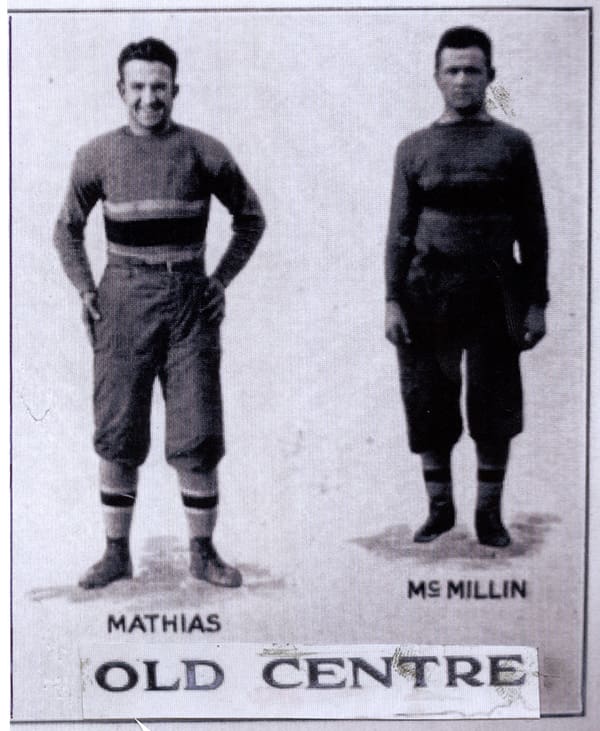
Bob Mathias and Reuben McMillin-photo taken in the fall of 1916

Again, in order to better understand how the Fort Worth North Side High connection was vital in building the team, let's take another look at the 6 players who Chief Myers took to Danville by train in 1916 and see how that worked out.
Former North Side players who traveled to Centre in 1916 with Chief Myers
PLAYER | GRADUATED FROM | ENTERED CENTRE |
|---|---|---|
Reuben McMillin | 1912 | 1916 |
Bob Mathias | 1915 | 1916 |
Matty Bell | 1916 | 1916 |
Red Weaver* | 1916 | 1917 |
Bo McMillin* | 1916 | 1917 |
Thad McDonnell* | 1916 | 1917 |
*Were denied admission in 1916
When Chief Myers arrived in Danville with plans to enroll the 6, it was discovered that Red Weaver, Bo McMillin, and Thad McDonnell didn't have enough high school credits to meet Centre’s entrance requirements.
The other 3, Reuben McMillin and Bob Mathias along with Matty Bell, were enrolled successfully and played on the 1916 Centre football team as shown below.
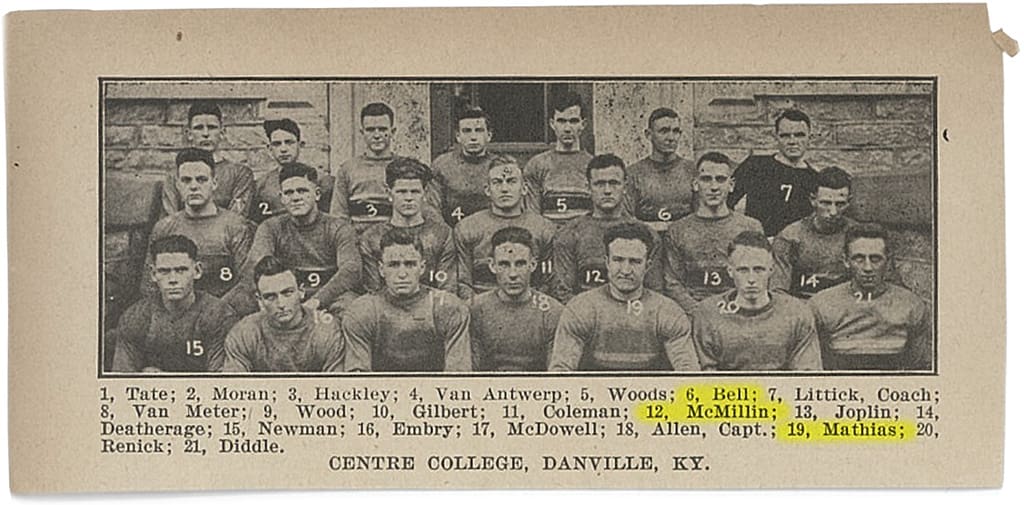
1916 Centre Colonels
There were 3 Fort Worth North Side players on 1916 Centre team- ( 6 ) Matty Bell ( 12 ) Reuben McMillin ( 19 ) Bob Mathias
For Bo McMillin, especially, it wasn't due to lack of intelligence that he was denied enrollment by Centre but simply that he hadn't completed enough classes.

Bo's North Side report card for what would have been his junior year. Even at his own high school, Bo's last name was spelled incorrectly as "McMillan." One of the reasons why Bo didn't have enough credits to enter Centre in 1916 may be revealed by this report card. There are no credits given the first semester.
Centre and the Somerset, Kentucky Connection
Chief Myers contacted Paul Dexheimer in Somerset, Kentucky, the football coach there, and managed to get the three who Centre wouldn't accept, Bo McMillin, Red Weaver, and Thad McDonnell, enrolled at Somerset High School, 50 miles south of Danville, for the 1916-17 school year in order to earn enough credits to be enrolled at Centre the following year.

Somerset High School
They joined Red Roberts, a 200 plus pound junior where they became one of the most powerful Kentucky high school teams of the era.

1916 Somerset "Briar Jumpers.( 1 )" Bo" McMillin ( 2 ) Red Weaver ( 3 ) Red Roberts ( 4 ) Thad McDonnell
Somerset beat a highly favored Louisville Boys High School, recently established by merging Louisville Male and Manual Training, 51-6. It was considered one of the greatest upsets ever in the history of Kentucky high school football. The "Briar Jumpers" were described as "rabbits jumping through a briar patch" as they romped all over the field in dispatching the Boys High team, a play on the Somerset school's nickname which furthered enhanced it.
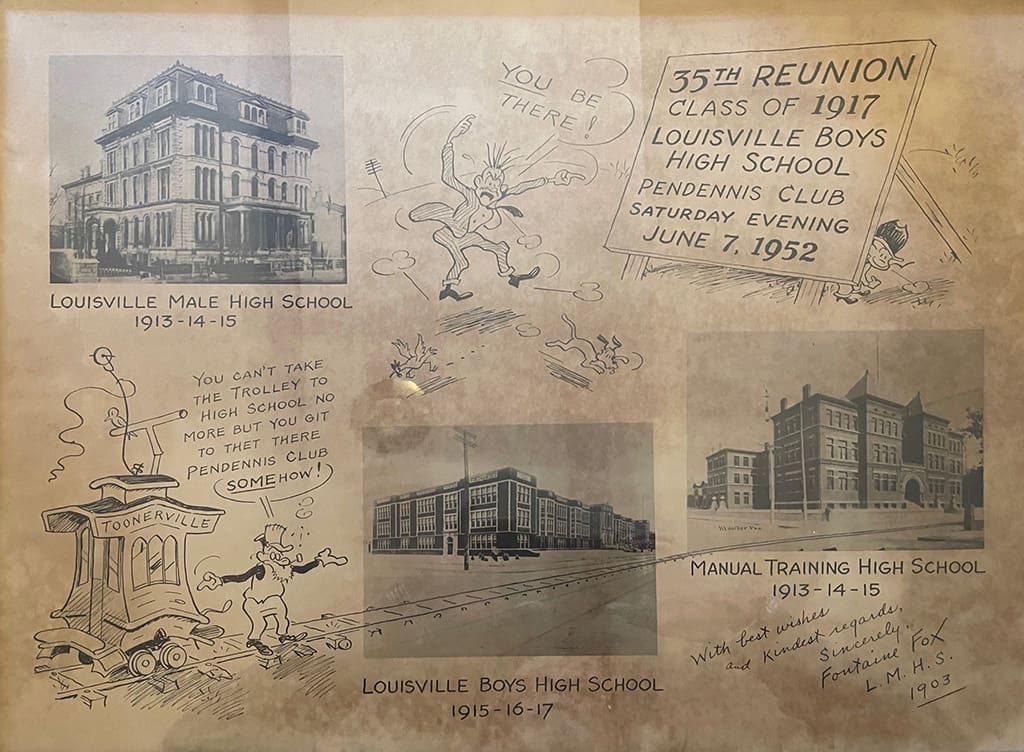
Large poster produced by Fontaine Fox about the 35th reunion of boys who were associated with Louisville's Male and Manual Training High Schools and the newly created, merged Louisville Boys High School. Fontaine Fox created the nationally syndicated "Toonerville Folks" comic panel which ran from 1913 to 1955, published in over 250 newspapers. This reunion of the 1917 class would have included members of the team that Somerset High so thoroughly destroyed in the fall of 1916.
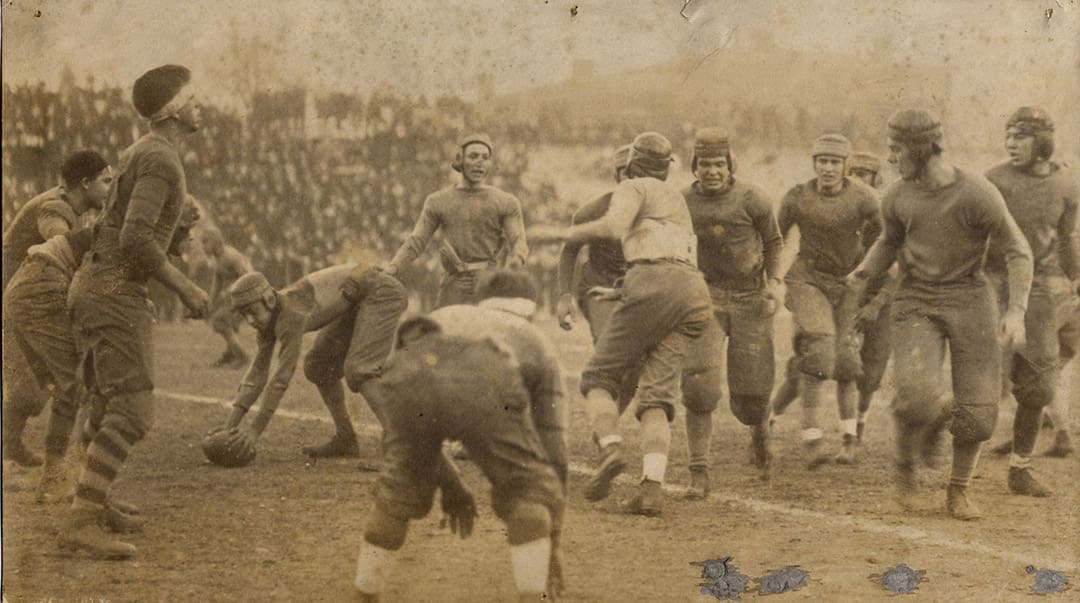
Somerset High in action against Louisville Boys High in 1916. Red Weaver, standing, headband left. Red Roberts, headband, crouching. Bo McMillin, lighter jersey, rushing the line. It appears that McMillin may be jumping offsides.

Story about the Somerset "Briar Jumpers" destroying heavily favored Louisville Boys High in 1916 which had been created by merging Louisville's Male and Manual High in 1915. Former Fort Worth North Side stars Red Weaver and Bo McMillin played for Somerset during the 1916 season along with local Red Roberts, with all 3 highlighted in the lineup of the box score. Bo had 3 TD's in the game. Red Roberts kicked a field goal.
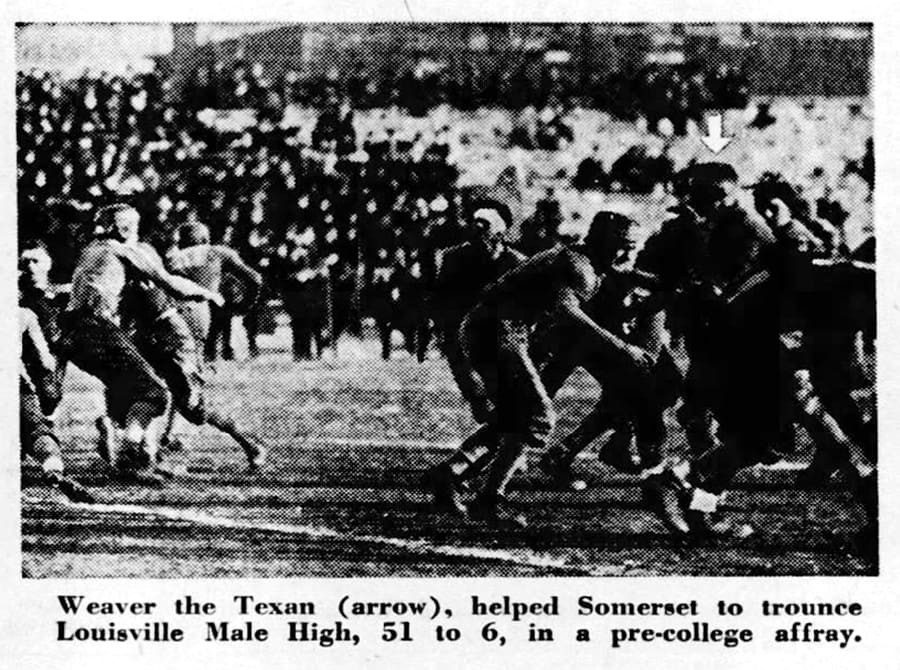
Red Weaver, white arrow, top right, in action during Somerset's dominating win over Boys High
Somerset was undefeated going into the 1916 Kentucky State High School Championship game which ended in a scoreless tie with Lexington High at the University of Kentucky's Stoll Field.

Somerset High and Lexington High played to a scoreless tie in the 1916 Kentucky State Championship game even though the "Briar Jumpers" were statistically the better team.
Over the next years, all of the 9 Fort Worth North Side players listed below plus Somerset's Red Roberts became a huge part of Centre’s success and were a large factor in Chief Myers playing a major role in the college’s reaching prominence, and ultimately dominance, in the world of college football in the years after the end of World War I.
PLAYER | GRADUATED FROM | ENTERED CENTRE |
|---|---|---|
Reuben McMillin | 1912 | 1916 |
Bob Mathias | 1915 | 1916 |
Matty Bell | 1916 | 1916 |
Red Weaver | 1916 | 1917 |
Bo McMillin | 1916 | 1917 |
Thad McDonnell* | 1916 | 1917 |
Bill James | 1917 | 1917 |
Bill Boswell | 1917 | 1917 |
Sully Montgomery | 1918 | 1918 |
Red Roberts | Cell | 1918 |
( *Thad McDonnell became the Centre team manager and never actually played as can best be determined. )
College Football and the "Big 3"
So, how, and why did the “Big 3” of Harvard, Yale, and Princeton fit into Chief Myers’ plans for Centre to gain national prominence in the world of college football?
To understand his reasoning and game plan for achieving his goals for Centre, it is necessary to understand the college football landscape from the inception of the game and its evolution over the next 5 decades.
For the initial 50 years after the first college football game in 1869, until the resumption of play after the war years of 1917-18, the Eastern schools had been recognized as constantly placing the most talent on the gridiron.
This was particularly true of the “Big 3”- Harvard, Yale and Princeton. Not only did they dominate college football, but there was feeling on their campuses that they somewhat ruled the country, and perhaps the world, due to their "old boy" network of distinguished graduates.
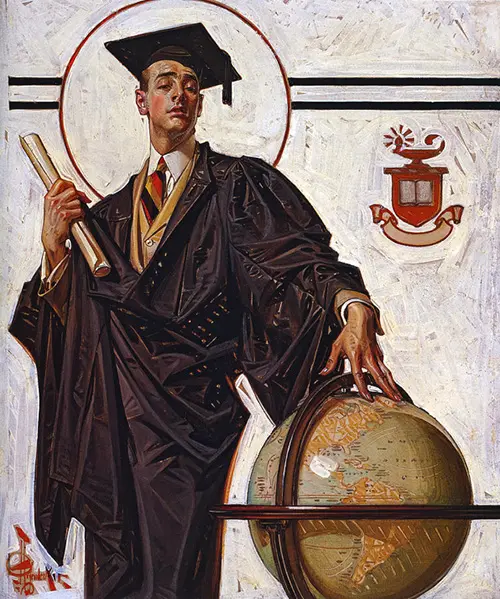
"Big 3" graduate - "Got the whole world in his hands"
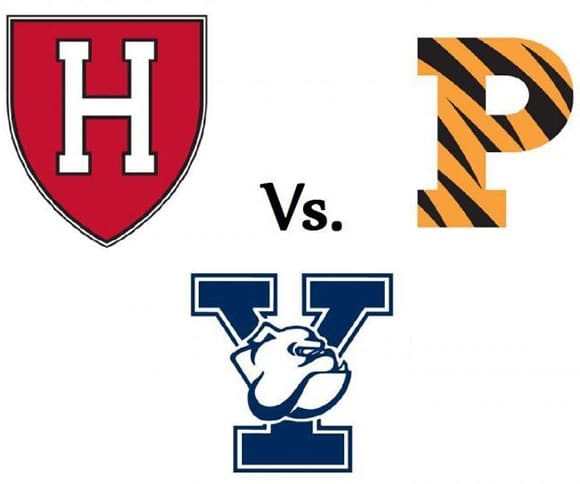
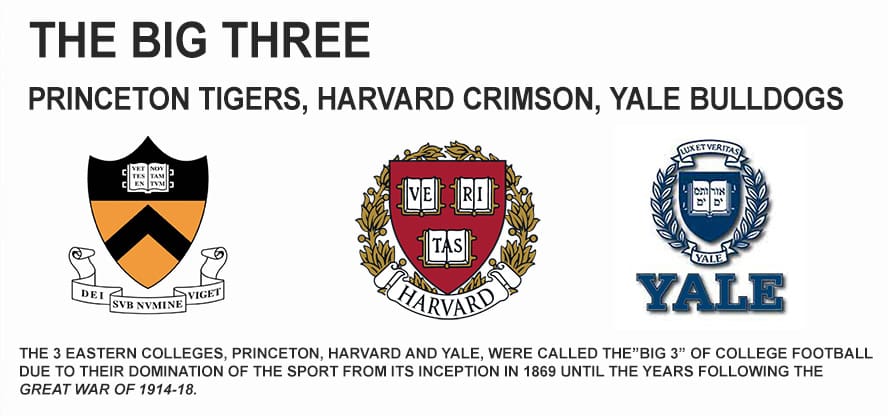
There was no “Ivy League” as we know it now. That term came into use in the 1930’s, and the actual conference didn’t exist until 1956. However, the “Big 3” reigned supreme for over 50 years. Often their only loss would be to each other, as they would roll over all other competition.
Even though Harvard, Yale, and Princeton played for decades before 1900, it is pertinent to see how the Eastern superpowers fared from 1900 through 1916, the last normal, full season recognized by most colleges before the war years interrupted many football programs.
1900-1916
WON LOST TIES %WINS*
Yale 154 19 13 89.0%
Harvard 145 20 7 87.0%
Princeton 125 25 11 83.3%
Overall 424 64 31 86.5%
*Ties not included in percentages
Of the 64 losses that the 3 colleges sustained, 36 were to each other.
It was somewhat like fratricide!
If those 36 wins and losses are excluded, again not counting ties, Harvard, Yale, and Princeton had a 93.3% winning record against all other opponents.
The “Big 3” were justly named, and it was their reputation as members of football royalty which caused Robert L. Myers to put such importance on Centre someday joining them on the throne.
As the Chief dreamed in Fort Worth, the "Big 3" continued as college football's premier programs by playing in the castles which they had built on their campuses.
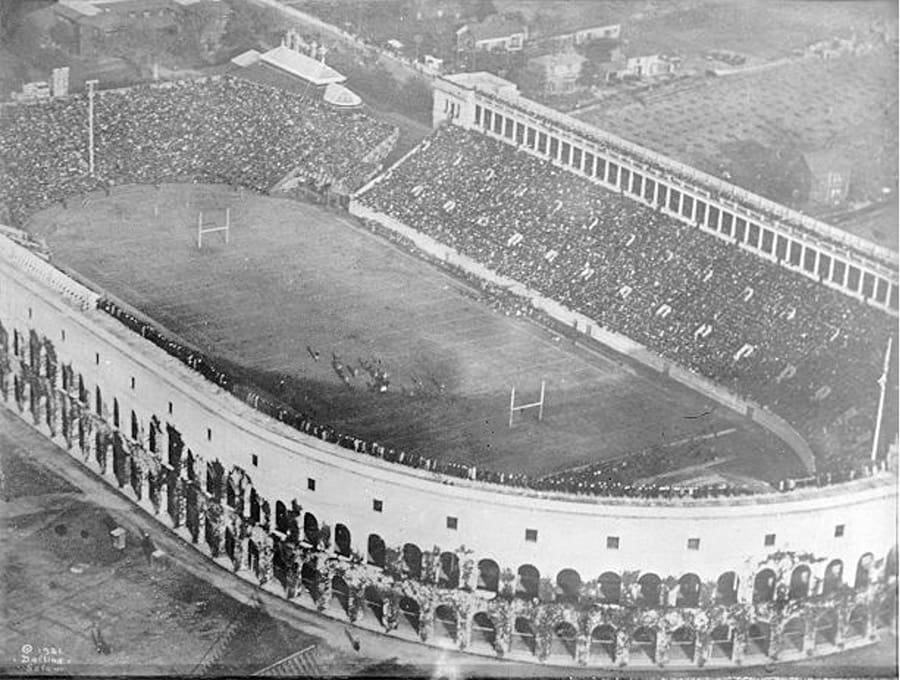
Harvard Stadium, built in 1903

The Yale Bowl, 1914
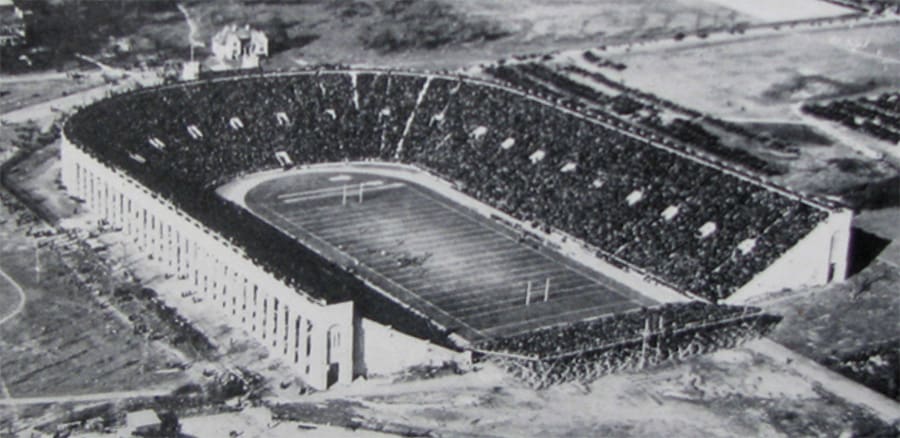
Princeton's 1914 Palmer Stadium
The 1917 Season Begins- "Chief" Myers and "Uncle Charlie" Moran
Chief Myers learned after his disappointment about not securing the Centre football coaching position in the fall of 1916, when he had taken his North Side players to Centre for enrollment, that it was going to be available in 1917 as Orville B. Littick had resigned as coach and accepted a similar position at Beloit College in Wisconsin.
Myers applied and was accepted and became the Colonels’ coach. His tenure was short.
Centre beat a hapless Kentucky Military Institute team on October 6, 1917, 104-0.
On October 20, the team traveled to Greencastle, Indiana to play the DePauw Tigers and was shutout, losing 6-0.
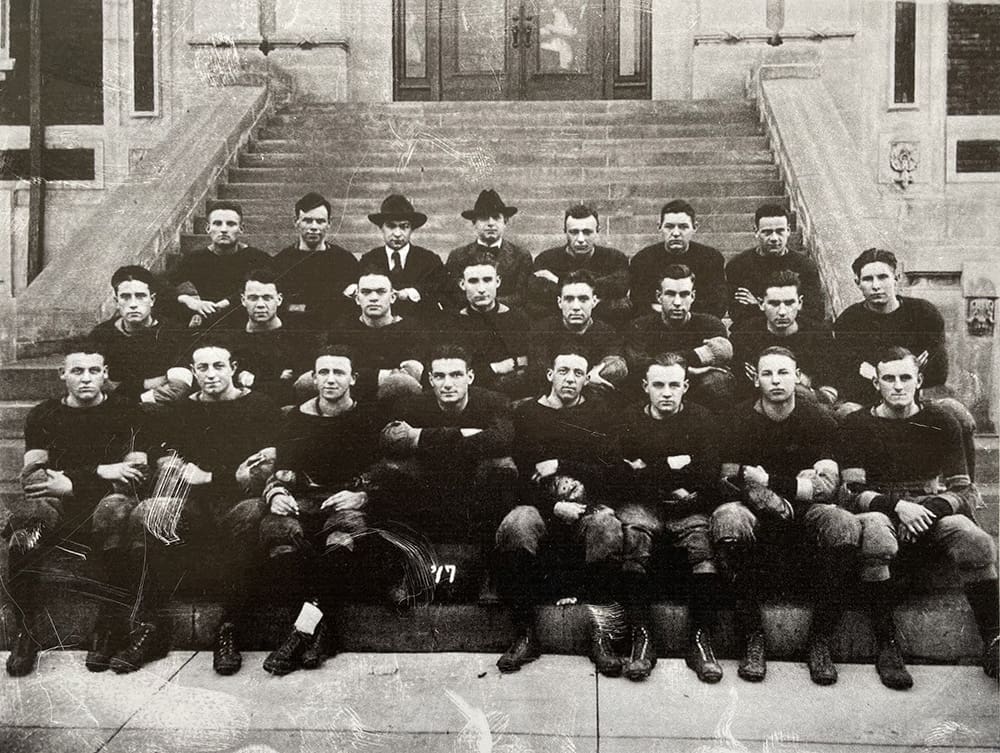
DePauw-1917, the only team to beat Centre until the Harvard game of October 23, 1920
The following Monday, a rather distinguished appearing man showed up at Centre’s practice and offered a few suggestions about offensive plays to Chief Myers. It was realized that he had a son, Tom, on the team, and he’d stopped by to check on him.
The man was 39 year-old Charles Barthell “Uncle Charlie” Moran, a National League baseball umpire who was the former head football coach at Texas A&M from 1909 through 1914. Moran was known as an offensive genius and had compiled a 38-8-4 record during his 6 years in College Station.

Tom Moran

Charles Barthell Moran- "Uncle Charlie"

Uncle Charlie and Tom Moran

National League umpire Charles Moran
Chief Myers knew all about Moran as their years in Texas overlapped from 1912 through the 1914 season. He realized that he was in the presence of someone who far surpassed himself regarding football knowledge, and before the afternoon was over, Centre had a new football coach.
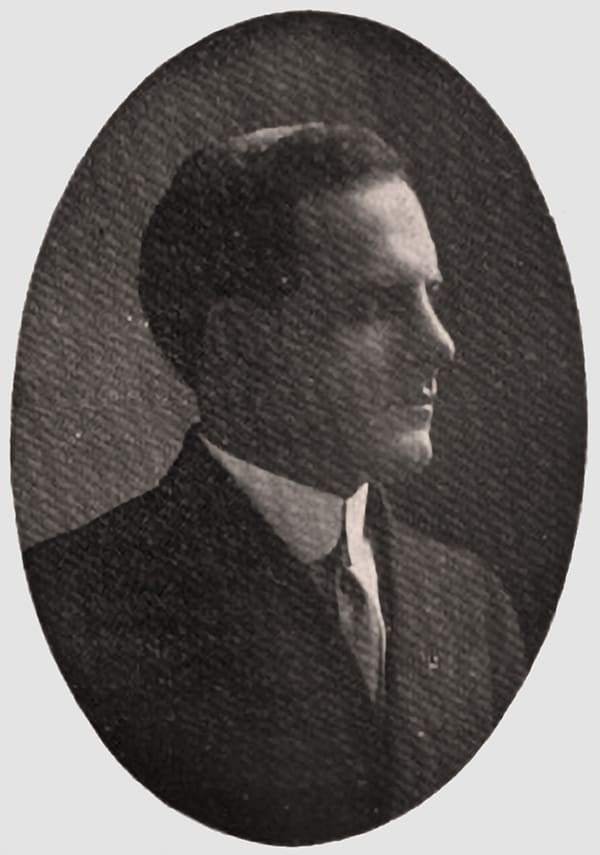
Charles "Uncle Charlie" Moran from the Texas A&M yearbook
It was a measure of the man that Chief Myers relinquished the head coaching job, a position he had dreamed about and finally obtained, because he realized that his vision of creating a nationally recognized college football power could best be achieved under the guidance of someone with Uncle Charlie’s skills.
Myers stepped aside and became the Athletic Director, working without pay, as did Moran.
Thus, the pieces were joining together which would allow Centre to enter the world of big-time, college football.
There was one other person who was an important player in Centre’s rise.
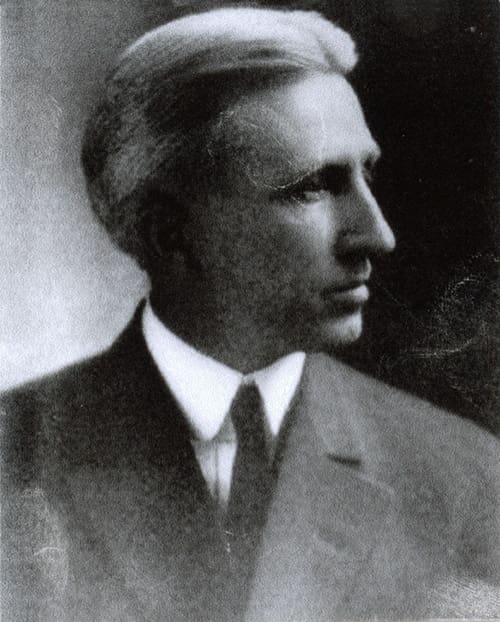
Dr. William A. Ganfield, Centre president from 1915-21, who was a key participant in the college's development of a nationally recognized football program
Dr. William A. Ganfield, Centre’s president, recognized that a successful football program could attract students to the little college, which had around 150 students at the time when he arrived in 1915, as well as being beneficial in increasing financial contributions to the institution. Ganfield served as president through the first semester of the 1921-22 academic year, important years as Centre developed into a football power.
After Moran became head coach, Centre became a different team and won the next 6 games, shutting out all of its opponents, and outscoring them, 143-0.
The 1917 Season
1917 Season ( 7-1-0 ) | ||
|---|---|---|
Oct. 6 | Centre 104 | KMI 0 |
Oct. 20 | Centre 0 | DePauw 6 |
Oct. 27 | Centre 34 | Maryville 0 |
Nov. 3 | Centre 3 | Kentucky 0 |
Nov. 9 | Centre 37 | Ky. Wesleyan 0 |
Nov. 17 | Centre 28 | Sewanee 0 |
Nov. 24 | Centre 28 | Transylvania 0 |
Nov. 30 | Centre 13 | Georgetown 0 |
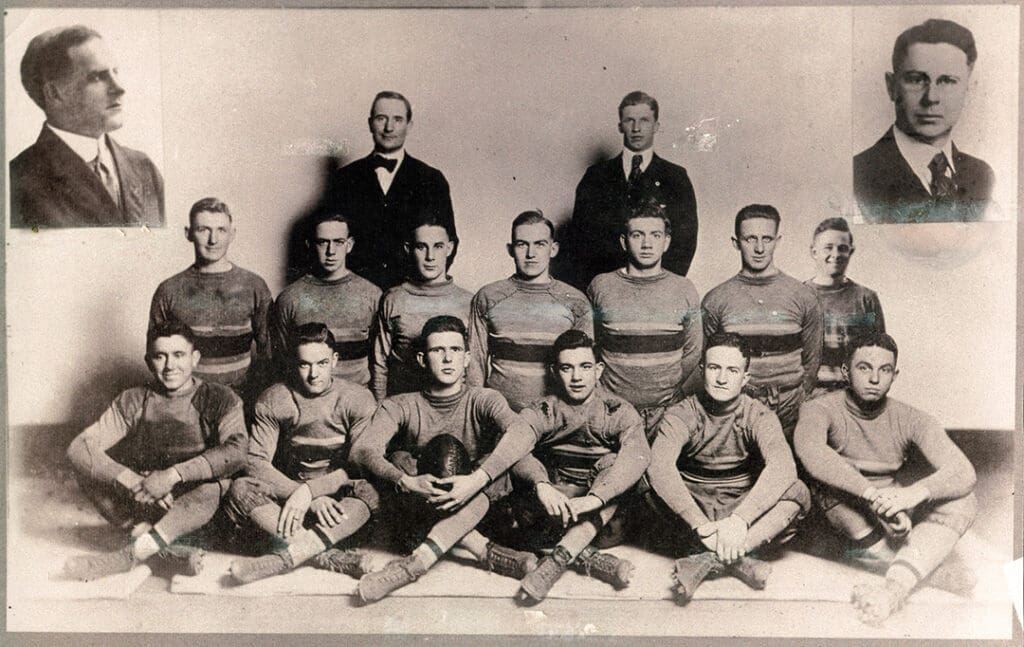
1917 Centre College football team
Front row -left to right: McMillin, Armstrong, Tate ( captain ) Moran, Mathias, Boswell
Second row- left to right: Bell, Weaver, Allen, Coleman, Van Antwerp, Diddle, Penn
Top-Coach Moran, far left and Chief Myers, far right
The two men at top center are-Assistant Coach Green and Team Manager, Rue. Reuben McMillin would have left Danville to return to Fort Worth by the time this team photo was made. ( See below. ) Bill James was not in the picture. ( Bold face- Fort Worth North Side players )
Ed Diddle ( 1895-1970 ), shown above 2nd from right on the second row, became a legendary basketball coach at Western Kentucky Normal School and Teachers College ( Western Kentucky University ) after leaving Centre. He coached the "Hilltoppers" from 1922-64 and in his 43 years there compiled a 759-302 record, winning 71.5% of his games. He was enshrined into the Naismith College Basketball of Fame in 1972 and elected to the founding class of the National Collegiate Basketball Hall of Fame when it was established in 2006.
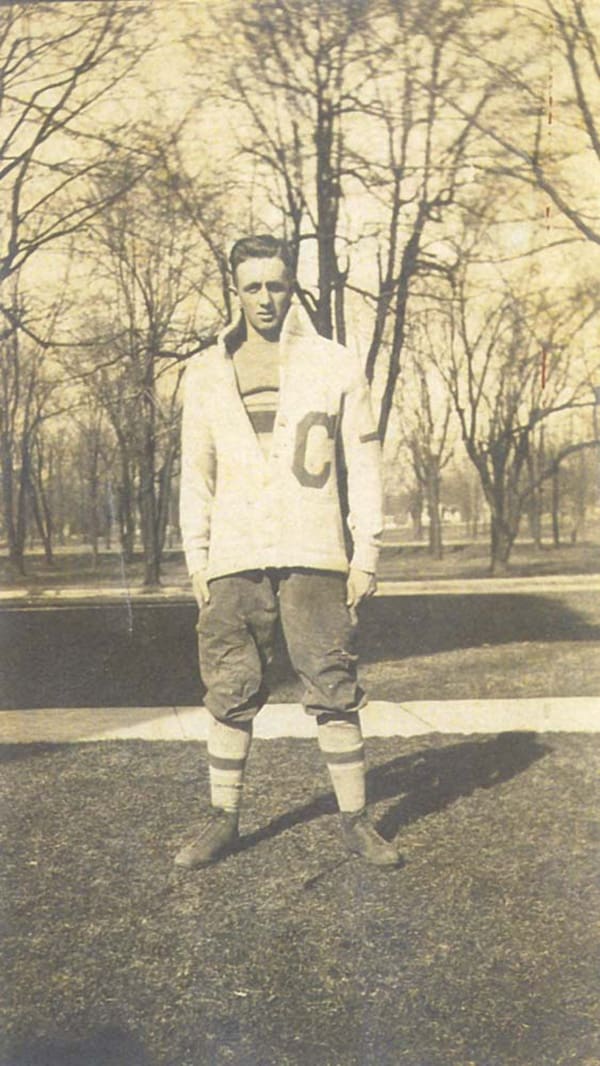
Ed Diddle on Centre campus
Centre had a goal of being the top team in Kentucky, and that meant beating Georgetown, Transylvania, and Kentucky.
The first part of reaching that goal began when Centre beat Kentucky on November 3, 1917, 3-0.
The Beginning of the "Praying Colonels" Legend
Prior to the Kentucky game, the players noticed when they were suiting up that Reuben McMillin wasn't in the locker room. Uncle Charlie was asked about it and stated that there had been a call from Fort Worth about a crisis in the McMillin family and that one of the brothers needed to get on a train and return home as soon as possible.
"I am a God-fearing man," Uncle Charlie said. "I may not practice a formal religion, but I believe there is a higher authority that guides us in our lives. Reuben sacrificed himself for the team. He has been here longer than Bo, but Rube came to me and said he'd be the one to return home, because the team needed Bo more. Perhaps we should bow our heads and ask for Divine Guidance from the power above as we enter into this game."
There was a moment of silence, and then Bob Mathias burst out, "Damnit Unc! Let me pray!"

Bob Mathias- "Damnit Unc! Let me pray!"
It was never revealed exactly what the Centre fullback said, but lineman Howard Van Antwerp related later that there wasn't a dry eye in the dressing room as the Colonels jumped to their feet at the final "amen" and raced out onto the field.
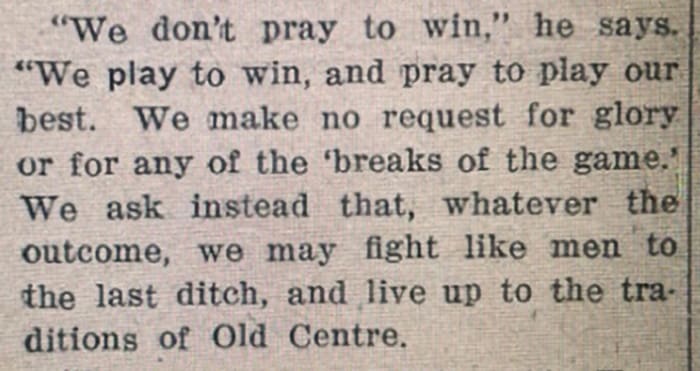
Bo's comment whenever he was asked about the prayer before every game
Thus was born the a tradition that began on November 3, 1917 and has endured now for over a century as the Centre College Colonels became the "Praying Colonels."
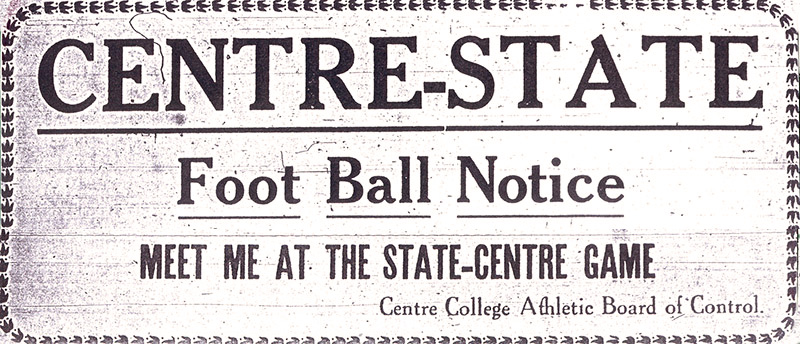
Notice about upcoming 1917 Centre-Kentucky game
By beating Kentucky, 3-0, on a field goal kicked by Bo McMillin, who later admitted that he had never attempted a field goal during a game before, Centre avenged the 68-0 win of the Wildcats the year before in Lexington and then shut out Transylvania, 28-0, and Georgetown, 13-0, beginning a dominance over their Kentucky rivals which carried over for the next decade.

The winning kick in Centre's 1917 win over Kentucky. The ball can be seen high above the goal post. The Boyle-Humphrey Gymnasium is in the background.
The 1918 Season
The following year, 1918, was a strange one for Centre’s football team.
The combination of the United States being involved in World War I along with the “Spanish Influenza” pandemic resulted in most colleges either totally shutting down their programs, or greatly curtailing them. Centre played the two nearby Kentucky colleges, Transylvania and Georgetown, and two military bases, Great Lakes Naval Base from Illinois and Camp Zachary Taylor situated in Louisville.
( Great Lakes fielded more than one team in 1918 and the one sent to Danville was not the one which played in the Rose Bowl on January 1, 1919 and defeated the Mare Island Marines, 17-0. )
Kentucky played 3 games, beating Indiana and Georgetown (KY) and losing to Vanderbilt, and then shut down its program after its November 9 game with Georgetown and didn't play Centre in 1918.
The Colonels easily beat in-state rivals, Transylvania and Georgetown. The service teams were tougher, but the Colonels managed to defeat both.
1918 Season ( 4-0-0 ) | ||
|---|---|---|
Nov. 2 | Centre 52 | Transylvania 3 |
Nov. 9 | Centre 23 | Great Lakes 0 |
Nov. 22 | Centre 10 | Zachary Taylor 7 |
Nov. 28 | Centre 83 | Georgetown 3 |

The shortened season actually produced some benefits.
By playing the two military based teams at Danville, a significant number of college football players from across the country who were playing at the bases were exposed to both Centre College and its team and players for the first time.
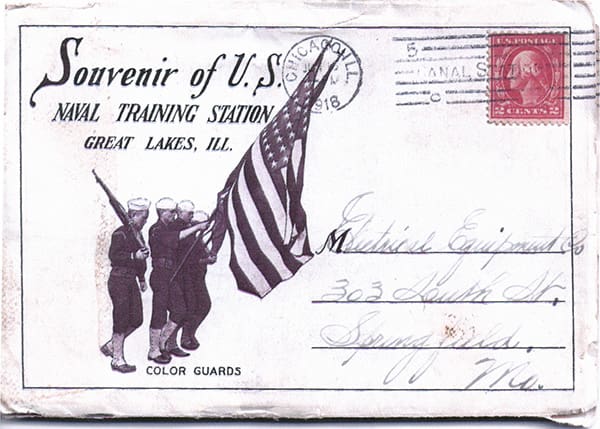
Centre beat the Great Lakes Naval Training Station team, 23-0

In 1918, Camp Zachary Taylor fielded a service team which Centre beat, 10-7
The fact that the Colonels beat both teams created a very favorable impression about the quality of Centre’s players which would be of significant importance. When the service members were discharged and returned to their campuses across the country at the end of the war, they spread the word that something was going on in Danville, Kentucky deserving attention.

Bo's running and a Red Roberts 50-yard field goal were decisive.

A Bo to Army Armstrong TD pass provided the winning margin

5 of the Colonels highlighted against Camp Zachary Taylor were Chief Myers' young men from Fort Worth North Side High.
Walter Camp, widely accepted as the authority in college football during its early years, mentioned Centre favorably in Spalding’s Official “Foot Ball Guide” in the 1919 issue, which he edited, covering the results from the 1918 season.


Summary of Centre's 1918 season in the 1919 "Official Football Guide" which included the comment that "Centre gained wide recognition."
Chief Myers had sought recognition for his college and team.
It first began during and after the shortened 1918 season.